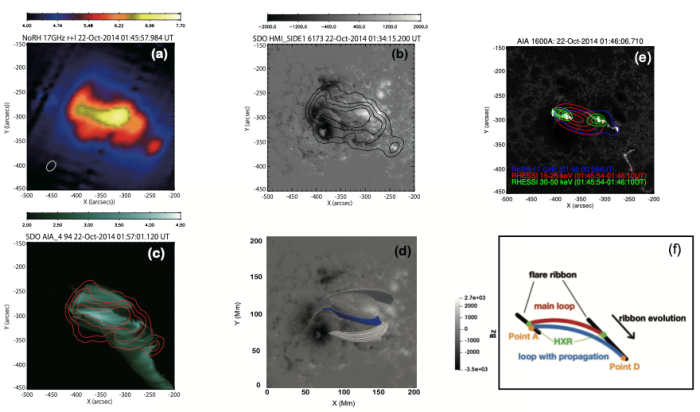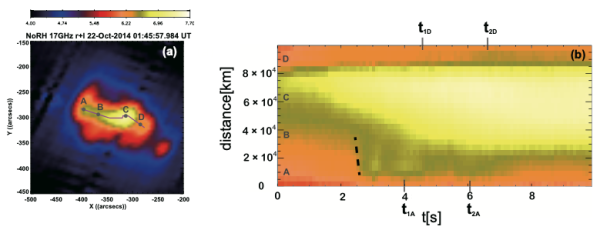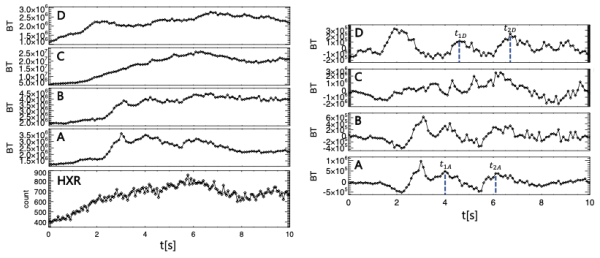Bouncing motions of fast electrons using Nobeyama Radioheliograph
| Nugget | |
|---|---|
| Number: | 459 |
| 1st Author: | Keitarou MATSUMOTO |
| 2nd Author: | |
| Published: | November 6, 2023 |
| Next Nugget: | TBD |
| Previous Nugget: | Impact of nanoflare heating in the lower solar atmosphere |
Introduction
When a solar flare occurs, many particles are accelerated. It is noteworthy that approximately fifty percent of the total energy discharged by solar flares may appear in the kinetic energy of fast electrons. However we do not observe the accelerated electrons directly, and remain unclear about the acceleration mechanism that produces them. Several models for the acceleration mechanism have been proposed by various authors, and these may differ in terms of the pitch-angle distribution of the electrons they energize.
The non-thermal radiations from the accelerated electrons are important to understand the acceleration mechanisms, and fortunately solar flares emit strong non-thermal microwave gyro synchrotron radiation. This depends strongly on the pitch angle of the electrons. That's one of the reasons why non-thermal radiation is essential to understand the acceleration mechanism.
The Nobeyama Radio Heliograph (NoRH) observed solar flares at two microwave frequencies (17 and 34GHz). The time resolution was 0.1 seconds, meaning that it could capture the short time scales of the solar flares, even following the motion of the electrons. An early investigation (Ref. [1]) did study the high-speed propagation of the microwave sources using NoRH and discussed the pitch-angle distributions of the accelerated electrons. However, before the launch of the SDO satellite with its high-resolution EUV imaging, this work could not be put in the context of the coronal magnetic field properly. We have now analyzed another flare event from the SDO era and discuss the physics of this flare taking advantage of the better time resolution.
Observations
We analyze the GOES M8.7-class flare SOL2014-10-22, from the very productive NOAA Active Region (AR) 12192. The analysis uses NoRH, the Solar Dynamics Observatory (SDO), RHESSI, the Fermi Gamma-ray Burst Monitor (GBM), and magnetic-field extrapolations via an NLFFF model as shown in Figure 1.

Figure 2 shows the slit along the coronal loop interconnecting Points A and D and time variation of the brightness temperature at 17 GHz along the slit. Comparing with Figure 1 (c) and (d), we conclude that Points A and D are the footpoints of the same coronal loop shown as blue lines in Figure 1 (d).

Periodic enhancement of the microwave radiation at the footpoints
The right panels in Figure 3 show cyclical brightenings observed at both footpoints (Points A and D). The peak times were 4.0 s (1A) and 6.1 s (2A) at Point A. For Point D, the peak times were 4.6 s (1D) and 6.7 s (2D). We suggest that the injection of accelerated electrons occurred somewhere in this loop.
Using the information on the coronal magnetic field of the loop in the NLFFF model and some assumptions, we conclude that this periodic enhancement may be caused due to the bouncing motion of the accelerated electrons at the footpoints.

Conclusions
We discuss the possibility for explaining the enhancement of the microwave radiation at the footpoints after considering the pitch angle of the electrons and the size of the loss cone at the footpoints. This analysis improves upon that of Ref. [1] owing to the availability of SDO observations and the use of an NLFFF model. It is likely that the bouncing motion of the accelerated electrons can explain this periodic enhancement. Please see Ref. [2] for full detail.